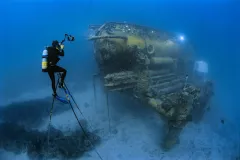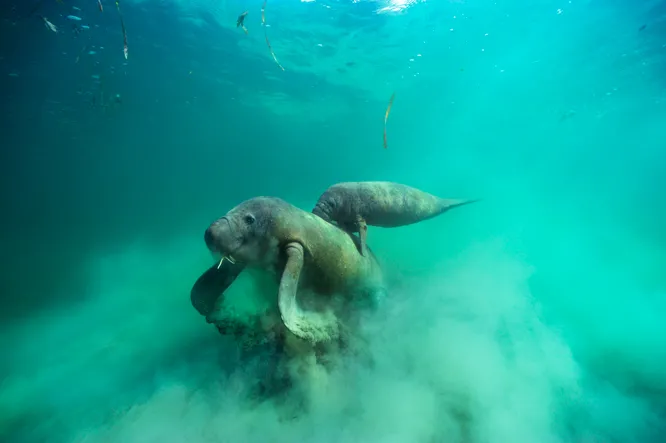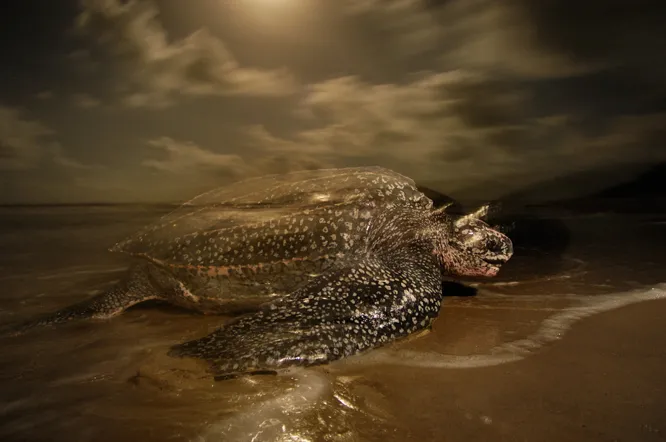Portraits of Planet Ocean – Behind The Photographs

As an assignment photographer, I sometimes feel as though I am living in a vacuum, spending months each year in the field focused on my work. When everything comes together and I climb back on the boat with an image I had envisioned (or one that is even better), I am naturally relieved and pleased. But in an exhibit, my photos take on a new life as visitors from many different backgrounds experience them for themselves.
In my new exhibit, Portraits of Planet Ocean, the creative team at The Smithsonian National Museum of Natural History has designed an inspiring way to experience ocean exploration and wildlife featuring a collection of some of my favorite photographs, along with their stories. Given this very unique show that not only focuses on the photographs but the conservation themes that emerge amongst them, I am especially anxious to hear from those who have visited.
Photographic appreciation is of course subjective—what one person likes may not appeal to another. And people have a variety of reasons for appreciating specific images, whether that is a connection to a specific location or species, or a gut reaction. As an editor at National Geographic Magazine once told me, “The pictures and story are yours when you're in the field. Then they become ours and then, [...] they belong to everyone.”
In this blog, I wanted to share some behind-the-scenes moments from three of the exhibit’s photos so you know what they mean to me. Then I look forward to hearing what all of the photographs say to you in the comments!
Manatee Foraging with Calf on Her Back – The Mesoamerican Reef, the world’s second largest barrier reef, meanders through four countries: Mexico, Belize, Honduras and Guatemala. Far more than coral reefs however, it's part of a larger system of connected, interdependent ecosystems, including reefs, mangroves and seagrass beds. One charismatic animal that traverses all three is the manatee. Manatees in this region are not nearly as habituated to humans as their Florida cousins and typically shy away. On one special Belizean morning, however, I came upon a mother manatee with her calf who allowed me into their world.
Snorkeling slowly toward the pair, I fully expected them to see me and scurry off quickly. Instead, as the mom eyed me, she remained relaxed, just going about her business and nibbling on seagrass. I positioned my body with the sun to my back for optimal light on the animals and began to compose the scene in my viewfinder. The female was foraging furiously now, stirring up billowing clouds of mud and out of the clouds of silt I saw her calf appear. The baby swam over to its mom and tenderly held on to her back while she fed. Holding my breath, I inched ever closer beneath the surface and squeezed the shutter release, knowing I had my picture.
Female Leatherback Turtle Crawls From The Sea To Nest – Leatherback turtles are the oldest, deepest-diving and widest-ranging of all sea turtles, with a lineage that dates back over 100 million years. We can only imagine all that this species has seen and experienced throughout the millennia and yet today they are endangered and face a very uncertain future from human threats such as the harvesting of their eggs and entanglement in fishing gear. One of the most active leatherback nesting beaches in the world is on the Caribbean island of Trinidad, where they crawl from the sea at night and perform an ancient nesting ritual that often lasts nearly two hours.
Nesting turtles are easily disturbed by light, so the best conditions are those beaches that are in complete darkness. Rather than use a bright, white flash on my camera, I decided to time my work to coincide with a nearly full moon and use ambient moonlight to illuminate the scene. At about 2am on this particular night, a massive turtle emerged from the surf, laboring slowly up the beach. I moved into position and made a picture, using a slow shutter speed to allow the light from the moon to illuminate the turtle on the dimly lit beach. The result is a ghostly image of a magnificent, vanishing species.
Dead Thresher Shark Caught in a Gillnet - Currently, more than 100 million sharks are killed each year in our world’s ocean. This number may seem unfathomable, but researchers say that it may actually be a conservative estimate. While photographing a story about the global fish crisis, I wrestled with how I would make pictures of dead sharks that would resonate with readers. I wanted to evoke a response of alarm—but, to many people, sharks remain a creature to fear, so even technically excellent images of dead sharks might not move viewers to care.
Then one morning, while swimming along a gillnet off the Mexican coast, I found a thresher shark that had only recently gotten entangled and died. Its eye was open and, because it was a pelagic shark, it had long, outstretched pectoral fins threaded through the holes in the net. As I began to compose the frame, the scene struck me as a crucifixion, and finally I believed I had an image that would create empathy for these animals.




